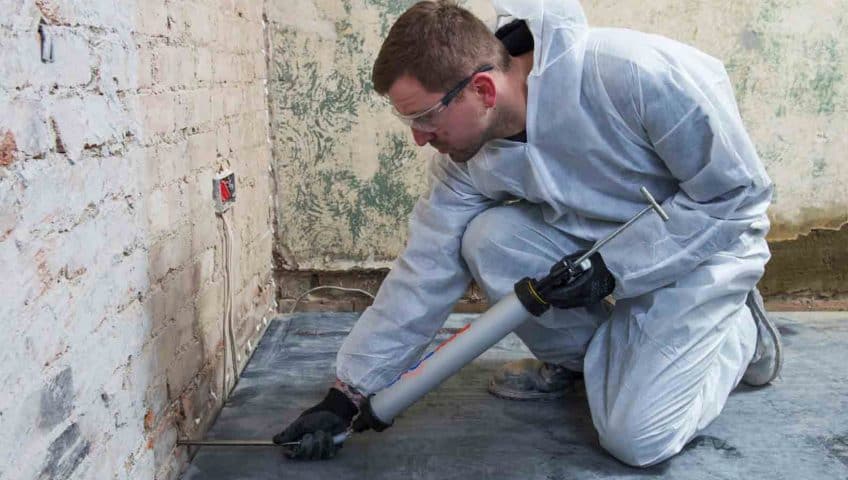
Mould Removal London
If you and your family have noticed that you are sneezing at home more often than usual, even if it’s not allergy season, it could be due to the presence of mould in your home. Mould can sometimes be hidden or undetectable during the early stages, so you may not always realise that it is present within your home. So, how exactly can you tell if there is mould in your home, and what should you do about it? Sadly, ignoring the problem or simply painting or wallpapering over it will not solve the problem.
Types of Damp Mould – What Causes It?
Whether it’s slimy black patches on a shower curtain or fuzzy white spots on the floor and walls, mould is often more than simply unsightly and disgusting to deal with. In many cases, mould can become a risk to the health of you and your family, especially if anybody is suffering from asthma or allergies. Knowing the causes behind mould in the home can be helpful in spotting these issues quickly and taking the necessary preventative measures to ensure that it does not spread.
There are six main causes of mould growth in a home. The combination of all six of these factors provides an environment where mould thrives, causing it to appear, develop, and spread quickly.
Mould Spores:
The mould spores themselves are the first cause of mould in your home. Mould spores are tiny microorganisms that are universally present both indoors and outdoors, making it difficult to prevent. They are invisible to the naked eye and can enter your home from the outdoors due to air movement or contaminated materials. It is impossible to remove all mould spores from your living space, however, you can eliminate the elements needed for mould to grow, to keep the conditions under control.
Moisture and Mould:
Moisture is the main thing that mould needs to thrive and grow. And while there is no specific level of humidity that mould spores need to thrive in, any slightly humid or damp area can often be enough. The longer damp conditions exist in your home, the higher the likelihood of mould developing, which is why it’s important to have any damp in your home identified and treated as quickly as possible. Moisture can occur due to leaks in the plumbing or roof and might often be in places that are not easily seen from inside the property. Mould spores will grow in these hidden areas, where they can quickly spread to other areas inside the property and take hold. Bathrooms in particular are notorious rooms for active mould growth since it is rare for every corner to be dry.
Food Source and Mould:
Since mould spores are an organism, they require food to thrive and grow. In outdoor spaces, food is provided by the endless organic materials and vegetation such as grass, soil, and trees. In indoor areas, mould spores will often feed off dust, dirt, or organic matter or the walls or wooden panels. Fabrics, cardboard, paper, carpets, and even wall insulation can all provide a food source for mould.
Poor Ventilation and Mould:
Without oxygen, mould is unable to survive since it requires oxygen to undergo the organic process of cell division and producing mass. Air circulation is also how mould spores are carried between spaces. Bear in mind that a large amount of air is not required for mould to thrive; trapped air under insulation, for example, can often be enough. Drying out damp areas with proper ventilation is the best way to prevent this.
Lack of Sunlight and Mould:
Direct exposure to sunlight can be fatal to mould as the ultraviolet rays can damage the cellular structure, which is why it is typically only found in dim or dark places. Unfortunately, indoor lighting does not have the same effect on mould since it does not release the same photons. As a result, it often shows up in those areas that are not often exposed to sunlight such as basements, attics, and bathrooms.
Temperature and Mould:
Mould is unable to survive in temperatures that are either too hot or too cold. Freezing can lead to mould spores becoming dormant, while heat damages the cellular structure. Typically, mould will thrive in a temperature range of around 20-25 degrees, particularly when the surrounding areas are damp and dark.
How to Get Rid of Mould Smell – Common Sources of Mould in the Home:
Every area in your home is home to several possibilities for mould spores to grow. Lack of ventilation in rooms and plumbing issues often result in optimal conditions for mould to thrive inside the home. Some of the common spaces in the house where mould is more likely to grow to include:
Mould in Attics:
Major and minor roof leaks are some common causes of mould in the attic. Missing or faulty insulation, snow, ice dam issues, condensation effects in the colder seasons, heaters and furnaces in the attic, and improper exhausting in the kitchen, dryer, or bathroom vents.
Mould in Bathroom:
Mould can occur in the bathroom due to a range of problems such as plumbing issues, water condensation on the walls and ceilings, wet surfaces from taking showers, failed grout or caulking between tiles, broken seals on bathroom furniture, water puddles around the sinks, frequently running water or poor air circulation, which all provide an optimum environment for mould to thrive.
Mould in Kitchen:
In kitchens, mould can be a result of water leaks from the sink or appliances such as dishwashers and washing machines. Steam from the dishwasher, cooking or boiling water in the kettle can also produce an environment where mould thrives.
Mould Removal Services – Do You Need Mould Removal London?
A professional mould removal service can remove the mould from various areas within your home. They will use a specially designed mould wash concentrate to clean the area, removing the mould with a fungicidal treatment. This treatment works across a variety of surfaces including painted surfaces, wood and tiles. It is more effective than bleach, which just wipes the mould from the surface without actually killing it.
If you need to have the mould removed from painted plaster walls, it is important to take extra care when preparing the surface since the mould can lead to flaking. Plasterboard walls are constructed from layers, and the mould can grow though all the layers, which usually means that the only way to effectively get rid of the mould is to replace the plasterboard completely.
Hiring a Mould Specialist – How Much Does Mould Treatment Cost?
The amount that you can expect to pay for the removal of mould in your home will depend on a number of factors including the type of mould, how far it has spread, and the areas where the mould is to be removed. Additional costs may need to be considered, for example, the replacement of affected plasterboard.
How to Get Rid of Mould Smell:
Once the mould has been removed from the walls in the home, it is possible for the smell to linger, although this is likely to go away after a while if the mould has been treated with a suitable fungicidal treatment. If the smell continues to linger, there may be mould present in other areas of the room that are hidden away, so it’s worth conducting a full inspection to ensure that all areas of mould are treated. Keeping rooms well-ventilated is the best way to remove the mould odour and ensure that the risk of mould regrowth is low.
Damp and Mould Paint – Finding the Best Anti Mould Paint:
Anti-mould paints contain biocides, however, they are as safe to use and apply as a regular emulsion paint. Anti-mould mains contain microbicides, which are designed to target microbes like viruses and bacteria, destroying them and inhibiting their growth. Anti-mould paints are also made with fungicides, which kill fungi and their spores, helping to tackle black mould growth in the home.
If you want to use anti-mould paint to prevent mould from developing in your home, it’s important to take sensible safety precautions. Be aware that benzisothiaszolone, one of the active ingredients in the paint, does have some side effects and can sometimes lead to allergic reactions including eye and skin irritation and contact dermatitis, which can range from an irritating rash to sore blisters on the skin.
Anti-mould paint is generally very effective for keeping mould at bay in your home. However, there are certain conditions in a home where it may not be as effective as it could be. For example, in the bathroom, anti-mould paint may be less effective if it is regularly filled with condensation from long daily showers and a lack of proper ventilation. Secondly, the biocides will degrade over time, so your anti-mould paint will not be forever effective and will need to be painted over after around every five years or so.
Mould in the home can be a serious problem. Not only is it disgusting to look at and has a foul smell, but it can make you seriously ill. If you suspect mould in your home, it’s best to act quickly.

